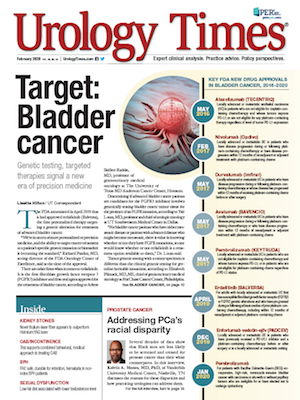TP-Bx: The answer to rising infectious complications?
"A more standardized protocol that is office based, reliable, and reproducible as well as cost- and time-efficient is required to entice more urologists to abandon the TRUS-BX approach," writes J. Brantley Thrasher, MD.

J. Brantley Thrasher, MD, a Urology Times editorial consultant, is executive director of the American Board of Urology, Charlottesville, VA.
The transrectal ultrasound-guided approach to prostate biopsy (TRUS-BX) has been one of the more frequently performed procedures for urologists for almost two decades. For many of us, it presented a significant advance in biopsy, using ultrasound guidance to more accurately image the prostate in lieu of digital rectal palpation. It also spared countless finger and glove biopsies known to be a significant occupational hazard. However, the use (and misuse) of antibiotics such as fluoroquinolones has resulted in growing concern over fluroquinolone-resistant (FQR) rectal flora and infectious complications following TRUS-BX.
A variety of strategies have been reported to address this concern. Identifying patients as high risk for quinolone resistance and adding a single dose of IM gentamicin or a second-generation cephalosporin such as ceftriaxone has been one effective strategy (J Urol 2013; 189:535–540). A more focused approach for high-risk patients such as a rectal swab and culture-directed antibiotic prophylaxis has also been recommended (J Urol 2012; 187:1275–90). Issa described the use of formalin disinfection of the biopsy needle to further reduce the risk of sepsis following TRUS-BX (J Urol 2013; 190:1769–75).
More recently, authors have successfully employed povidone-iodine rectal washes as an inexpensive agent to reduce post-biopsy infection and avoid additional antibiotic use (J Vis Exp 2015; [103]:52670). The transperineal approach to prostate biopsy (TP-BX) has seen a resurgence in popularity due to a lower risk of infectious complications (Urology 2013; 81:1142–6; BJU Int 2014; 114:384–8) and a similar prostate cancer detection rate (World J Surg Oncol 2019; 17:31). (See this month’s Hands On article.) However, widespread adoption has been hampered by the perceived problems of the need for general anesthesia to complete the biopsy and the subsequent increase in time and cost versus TRUS-BX.
Recent reports from the UK and Australia have described a more standardized local anesthetic approach to TP-BX that combines locally anesthetized perineal skin with a subcutaneous perineal nerve block combined with a standard periprostatic nerve block (Prostate Cancer Prostatic Dis 2017; 20:311–7; BJU Int 2017; 120:164–7). The authors reported excellent anesthesia, based on a patient-reported visual analog pain score. However, the approach was slightly different in the UK study, which included the addition of oral analgesia along with topical 2% diltiazem ointment and the use of lidocaine-infused gel into the rectum. These differences highlight the most significant impediment to the widespread adoption of TP-BX technique-the lack of a standardized protocol for anesthesia that provides a simple cost- and time-efficient biopsy technique as an alternative to TRUS-BX.
I don’t believe the issue here is that urologists are so firmly entrenched in TRUS-BX that they won’t embrace the need for an innovative strategy to reduce the risk of infectious complications. Urologists have proven to be innovators in a multitude of areas, including early adoption of ESWL, lasers, and robotics. Most see the wisdom of avoiding biopsies through the rectum as the flora continues to adapt to our strategies of adjusting antibiotic prophylaxis. However, a more standardized protocol that is office based, reliable, and reproducible as well as cost- and time-efficient is required to entice more urologists to abandon the TRUS-BX approach.
Send your comments to Dr. Thrasher c/o Urology Times, at urology_times@mmhgroup.com

Enzalutamide granted approval in EU for nmHSPC
April 24th 2024The approval is supported by data from the phase 3 EMBARK trial, which demonstrated that enzalutamide with or without leuprolide prolonged metastasis-free survival compared with leuprolide alone in patients with high-risk biochemically recurrent nmHSPC.
